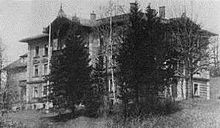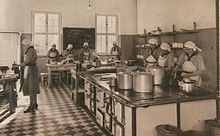Bavarian cookbook
The Bavarian Cookbook is a classic cookbook that has been published in more than 50 editions since 1931 . Together with the predecessors of the title, it will run for more than a hundred years. It is less an image of traditional Bavarian cuisine than a compilation of dishes that are popular and tried and tested in Bavaria and a continually updated kitchen and nutrition theory that is still used in home economics training.
history
The predecessor of the book was published in 1910 at the Miesbacher Wirtschaftliche Frauenschule founded in 1903, the cookbook of the Bavarian Association for economic women's schools in the country for young women and home economics teachers for "use in traveling cookery courses". These traveling cooking courses were held in winter (see winter school ) when work in the fields was stopped. The Miesbach hiking teachers, often so-called senior daughters , came to the villages with mobile cooking equipment and taught cooking and housekeeping .
The economic women's school in Miesbach, on the other hand, was in the tradition of the Reifensteiner schools initiated by the Prussian noblewoman Ida von Kortzfleisch and played an important role in women's education in Bavaria. With the Fehrhof, they also had a model farm. At that time, the culinary art in Bavaria was possibly not in very good shape. In any case, the writer Carry Brachvogel felt compelled to emphasize the necessity of the cooking courses mentioned in a brochure for the economic women's school :
"Then Bavaria will lose its well-established reputation for bad cuisine and even the broadest classes will learn that there are also very remarkable culinary provinces beyond dumplings and branding."
In 1932, from the 14th edition, the Miesbach teacher Maria Hofmann took on the cookbook and published it from then on as a Bavarian cookbook . The unmarried officer's daughter, born in 1904, was in charge of the Bavarian cookbook until her death in 1998. Hofmann is still today with the title of Oberregierungs-Landwirtschaftsratsin a. D. listed as author.
Her nephew, Professor of Internal Medicine Helmut Lydtin, has been involved since the 1960s and is now the editor. Lydtin got to know the book while doing research in the United States , where he had complained to his family about the local food. The beginner received his aunt's cookbook and learned to cook with it. The work, also known in the jargon as the savior of the daughter-in-law , the cookery bible or, due to the characteristic binding, is called Bavarian Blue , is published by Birken-Verlag , which was originally founded for this purpose . It now has a total circulation of over 1.6 million, and over 20,000 copies are still sold annually. The Miesbach women's school is now part of the Miesbach vocational training center; the Bavarian cookbook is still used there and in other institutions for training purposes.
The Bavarian Cookbook is a treasure trove for zeitgeist and developments in cultural history. Among other things, the world wars and National Socialism had an impact on recipes and word usage. French loanwords were replaced by German terms, such as mashed potatoes with mashed potatoes , stews were propagated, the style of the forewords changed. In 1938 the foreword was directed at the "woman who is in the forefront" and demanded that "ingredients from German soil" be preferred. Since Maria Hofmann had a broad horizon, the recipe section was expanded to include a number of international dishes such as porridge or turkey India, fried .
The Bavarian Cookbook
layout
There are hardly any images in the book, the first illustrations were not added until 1953. The characteristic cover colors (blue was only in use in 1971) were changed occasionally, as well as the format. The first volume was bound in yellow linen, as was the 36th edition from 1966, while the 3rd edition from 1916 had a green cover. The lettering, which is still the trademark of the Bavarian Cookbook, was created by the type artist Emil Preetorius .
content
The 1700 basic recipes are kept short. The book contains a well-founded culinary knowledge and a number of tips and tables for modern nutrition theory and the coordination of menus for festivals, recipes for health food and diets for various diseases of civilization such as obesity or diabetes mellitus . In the meantime there is also a chapter on alcoholic beverages, which also contains clear warnings: "However, alcohol is an extremely dangerous and very expensive calorie donor." Even a four-page " Small microwave customer " and directions about the recycling of aluminum foil were taken. The chapter “The Art of Right Seasoning” is still included. An alphabetical register facilitates the search.

The book contains recipes for typical southern German dishes such as apple strudel , knee noodles , baked udders or the in-house production of spleen sausage , but is not geared towards specialties of Bavarian cuisine , but rather efficient and versatile housekeeping. Recipe 938, Italian-style tomato sauce , also includes the bolognese sauce , and recipes for Hawaiian toast or pizza or a "diplomatic salad" with mushrooms and canned pineapple were also added in the 1970s . Tomatoes were mentioned even before World War I , which was unusual, as were a variety of vegetarian dishes including vegetarian brain . Among other things, Hofmann included recommendations and a salad recipe from Danish nutrition pioneer Mikkel Hindhede . However, the proposal to keep the defrosted water for frozen chickens and use it for the sauce is no longer included in the current editions.
Recipes were rarely taken out of the now almost 1,000-page cookbook, such as the tripe in the 1960s.
language
The book uses a number of Bavarian expressions such as curd cheese . The sound is occasionally involuntarily strange, which is what commands like do not open the tube! Cooking test! or advice on how increased rationalization requires increased thinking skills becomes evident. The sample menu suggestions for warm festive meals contain slightly antiquated advice such as costs are better calculated in advance than regretted afterwards. or The workload must not exceed the capacity, it must not become a strain for the housewife. Avoid working peaks shortly before serving, because they cause agitation, excitement and jeopardize success.
expenditure
- Maria Hofmann, Helmut Lydtin: Bavarian cookbook. 56th edition. Birken-Verlag, Munich 2007, ISBN 978-3-920105-04-8 .
reception
The Bavarian Cookbook is the most successful Bavarian book of all time. In 2015, his story was the subject of a small exhibition in the historic building of the former women's school in the state vocational school center in Miesbach. As part of a research project, the linguist Regina Frisch is examining the changes in the book over the course of the various editions as well as its mention in novels and other literature.
literature
- Regina Frisch: Hollerkücherl and elderberry cold bowl - dialect in the 'Bavarian Cookbook'. In: Evamaria Brockhoff (Red.); House of Bavarian History (Hrsg.): Wer ko der ko: Süddeutsch und Bairisch; lively dialect; linguistic standardization as a political instrument; Dialect and literature; at eich gfoit's ma. House of Bavarian History, Augsburg 2015, ISBN 978-3-7917-2638-0 , pp. 109–110.
- Regina Frisch: 100 years of cookbook history. Miesbach, the cradle of the Bavarian cookbook. Maurus, Miesbach 2015, ISBN 978-3-940324-10-8 (exhibition catalog).
- Regina Frisch: biography of a cookbook. The Bavarian cookbook tells cultural history. 1st edition. Verlag Friedrich Pustet, Regensburg 2016, ISBN 978-3-7917-2796-7 .
Web links
Individual evidence
- ↑ a b c d Bastian Huber: Bavaria's Bible for the kitchen. In: Merkur.de. November 14, 2014, accessed September 21, 2015 .
- ↑ a b Ursula Meyer, Waltraud Lücke: Economic women's school in the countryside in Bavaria, Miesbach . In: reifensteiner-verband.de . Retrieved December 6, 2016.
- ↑ a b c d e f g h i Hans Kratzer: Sauguad. The Bavarian Cookbook has been around for 100 years. It reflects the history of the kitchen and technology, language and zeitgeist. And you learn to cook with it too. In: Süddeutsche Zeitung , No. 244, October 23, 2015, p. R15.
- ↑ a b c d Bavarian television: Video "The Bavarian Cookbook" - Between Spessart and Karwendel. In: ARD Mediathek. Retrieved December 6, 2016 .
- ↑ a b c d Eva-Maria Magel: 80 years of “Bavarian Cookbook”: Don't be afraid of white sauce . In: Frankfurter Allgemeine Zeitung . February 22, 2014, ISSN 0174-4909 ( online [accessed December 6, 2016]).
- ↑ a b c Appetizing bestseller: The Bavarian Cookbook. In: BR.de. Retrieved September 21, 2015 .
- ↑ Susanne Breuss: ANSICHTSSACHE NO. 70: Exhibition and interview about the Bavarian cookbook by and with Regina Frisch. In: susannebreussalltagsdinge.blogspot.de. November 25, 2014, accessed December 6, 2016 .
- ↑ Maria Hofmann, Helmut Lydtin: Bavarian cookbook. Birken Verlag Munich, 56th edition, 2007, ISBN 978-3-920105-04-8 , pp. 775-798.
- ↑ Maria Hofmann, Helmut Lydtin: Bavarian cookbook. Birken Verlag Munich, 56th edition, 2007, ISBN 978-3-920105-04-8 , p. 775.
- ↑ Maria Hofmann, Helmut Lydtin: Bavarian cookbook. Birken Verlag Munich, 56th edition, 2007, ISBN 978-3-920105-04-8 , pp. 41-44.
- ↑ Maria Hofmann, Helmut Lydtin: Bavarian cookbook. , Birken Verlag Munich, 56th edition, 2007, ISBN 978-3-920105-04-8 , p. 31.
- ↑ a b Stefan Sessler: The cookbook of the century. In: Merkur.de. July 15, 2014, accessed September 21, 2015 .
- ↑ Maria Hofmann, Helmut Lydtin: Bavarian cookbook. Birken Verlag Munich, 56th edition, 2007, ISBN 978-3-920105-04-8 , p. 179.
- ↑ Maria Hofmann, Helmut Lydtin: Bavarian cookbook. , Birken Verlag Munich, 56th edition, 2007, ISBN 978-3-920105-04-8 , pp. 810-814.
- ↑ a b Maria Hofmann, Helmut Lydtin: Bavarian cookbook. , Birken Verlag Munich, 56th edition, 2007, ISBN 978-3-920105-04-8 , p. 811.
- ↑ The Bavarian Cookbook Wonder, OVB online 2014


